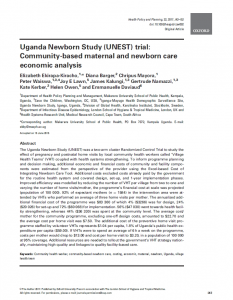
The Uganda Newborn Study (UNEST) was a two-arm cluster Randomized Control Trial to study the effect of pregnancy and postnatal home visits by local community health workers called ‘Village Health Teams’ (VHT) coupled with health systems strengthening. To inform programme planning and decision making, additional economic and financial costs of community and facility components were estimated from the perspective of the provider using the Excel-based Cost of Integrating Newborn Care Tool. Additional costs excluded costs already paid by the government for the routine health system and covered design, set-up, and 1-year implementation phases. Improved efficiency was modelled by reducing the number of VHT per village from two to one and varying the number of home visits/mother, the programme’s financial cost at scale was projected (population of 100 000). 92% of expectant mothers (n = 1584) in the intervention area were attended by VHTs who performed an average of three home visits per mother. The annualized additional financial cost of the programme was $83 360 of which 4% ($3266) was for design, 24% ($20 026) for set-up and 72% ($60 068) for implementation. 56% ($47 030) went towards health facility strengthening, whereas 44% ($36 330) was spent at the community level. The average cost/mother for the community programme, excluding one-off design costs, amounted to $22.70 and the average cost per home visit was $7.50. The additional cost of the preventive home visit programme staffed by volunteer VHTs represents $1.04 per capita, 1.8% of Uganda’s public health expenditure per capita ($59.00). If VHTs were to spend an average of 6 h a week on the programme, costs per mother would drop to $13.00 and cost per home visit to $3.20, in a population of 100 000 at 95% coverage. Additional resources are needed to rollout the government’s VHT strategy nationally, maintaining high quality and linkages to quality facility-based care.
*This article is part of a series of eight papers that includes the first multi-country, economic and systems analyses of community based maternal-newborn care. Access the series here >>